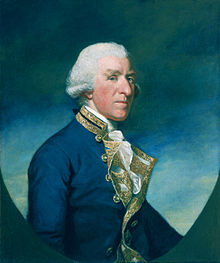Samuel Hood, 1st Viscount Hood
Samuel Hood, 1st Viscount Hood , GCB ( October 12, 1724 - January 27, 1816 in Bath ) was an admiral in the British Royal Navy .
Life
He was the son of Samuel Hood, Vicar of Butleigh, Somerset , and the older brother of Admiral Alexander Hood, 1st Viscount Bridport . Samuel Junior entered the Royal Navy on May 6, 1741 . As a midshipman he served part of his time with George Brydges Rodney on the Ludlow and he was promoted to lieutenant in 1746. He was lucky to serve among very active officers, including in the North Sea. In 1753 he became the commandant of the sloop HMS Jamaica and served on it in the North America area. In 1756 he was temporarily in command of the HMS Antelope . He drove a French ship ashore in the Bay of Audierrie and was able to capture two privateers . His services were known to the Admiralty , so that he soon got his own ship. In 1759 he was the captain of the Vestal and, after a tough battle, boarded the French ship Bellone (later renamed Repulse ). During the war he served in the English Channel all the time, and he was employed under Rodney in 1755 to sink the ships gathered by the French to transport troops for a planned invasion of England. In 1778 he took over a command that would normally have ended his active career at sea. He became overseer of the Portsmouth shipyard and governor of the Naval Academy. These offices were regularly given to officers who retired from seafaring. On May 19, 1778 he was in the Baronetage of Great Britain the title of Baronet , of Catherington in the County of Southampton.
During the royal visit to Portsmouth in 1780, he was appointed Baron Hood of Catherington in the Peerage of Ireland . Many admirals had refused to serve the then 1st Lord of the Admiralty under Lord Sandwich and Rodney, who was in command of the Caribbean at the time, complained about a lack of support from his subordinates, whom he accused of lack of commitment. The Admiralty was eager the services deserving old officers employed to secure and upgraded Hood on September 26, 1780. Rear Admiral (Rear Admiral) and sent him to the Caribbean, so he said to him personally known Rodney was to serve as deputy commander. He met Rodney on his flagship Barfleur in January 1781 and stayed in the Caribbean or on the North American coast until the end of the American Revolutionary War .
The expectation that he would work in harmony with Rodney was not entirely justified. The correspondence shows that they were not particularly friendly; but Hood always did his duty, and the question of removing him from his post never arose. The unfavorable outcome of the 1781 campaign resulted largely from Rodney's failure to heed Hood's advice. Had that Hood allowed himself to choose his post, he could possibly have prevented the Comte de Grasse from reaching Fort Royal with reinforcements from France in April. When Rodney returned to England for health reasons in the fall of 1781, Hood was ordered to return the hull of the fleet to the North American coast during the hurricane season. Hood Admiral Thomas Graves joined the unsuccessful attempt at relief for the trapped army in Yorktown. The British fleet was driven out of De Grasse during the Battle of Chesapeake .
In 1793 he became commander in chief of the Mediterranean Squadron. He got the order to block Toulon, the most important city of the French in the Mediterranean because their Mediterranean fleet was there. By the royalists he could even the city are taking . In December he had to evacuate the city because it was under fire from the French army, especially the artillery under a young captain named Napoleon Bonaparte . In 1794 he occupied Corsica and achieved some success.
In 1796 he was raised in the Peerage of Great Britain to Viscount Hood , of Whitley in the County of Warwick.
Lord Hood died in Bath in 1816, leaving a son.
Others
George Vancouver named Mount Hood , the highest mountain in what is now Oregon, and the Hood Canal , an arm of the Puget Sound , after the admiral.
The British Navy named their largest battle cruiser , the HMS Hood , "The mighty Hood" after him. The ship was built in 1918 and put into service two years later. The Hood was sunk on May 24, 1941 by the German battleship Bismarck .
Parts of this text are based on the Encyclopedia Britannica of 1911.
literature
- Hood, Samuel Hood, Viscount . In: Encyclopædia Britannica . 11th edition. tape 13 : Harmony - Hurstmonceaux . London 1910, p. 665 (English, full text [ Wikisource ]).
Web links
| predecessor | Office | successor |
|---|---|---|
| New title created |
Viscount Hood 1796-1816 |
Henry Hood |
| New title created |
Baron Hood of Catherington 1782-1816 |
Henry Hood |
| personal data | |
|---|---|
| SURNAME | Hood, Samuel, 1st Viscount Hood |
| ALTERNATIVE NAMES | Hood, Sir Samuel, 1st Baronet; Hood, Samuel, 1st Baron Hood of Catherington |
| BRIEF DESCRIPTION | British admiral |
| DATE OF BIRTH | October 12, 1724 |
| DATE OF DEATH | January 27, 1816 |
| Place of death | Bath |
